Badia a Coltibuono
by
KL Sullivan
Summary: If you are interested in a historical tour and a wine tasting, Badia a Coltibuono is an excellent site to visit. Our tour guide was knowledgeable and friendly. Enjoy viewing not only the11th century building but also the frescos and furniture throughout the touring area. A restaurant is located on the property.
The journey from San Gimignano to Badia a Coltibuono was along a long and circuitous route. Fortunately, the narrow roads were easily passable and traffic was minimal. At a few places roads narrowed to one lane over bridges. The vineyards and olive groves along the lower hillsides were clearly visible. As the roads rose up and around the hills of Chianti, deciduous trees covered with green and yellow foliage lined the way. Occasionally the road wanders through towns lining the way with stone houses built long ago. Visitors may want to plan extra time to stop and walk the local towns and perhaps to stop for lunch at one of the restaurants.
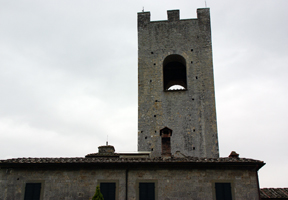 The approach to the winery leads to a spectacular view of a tall bell tower overlooking a valley of trees and high hills on the other side. The entrance is located on the far side of the church. The 11th century church is open but to access the wine tasting area ring the bell next to the side door. The vineyards and winery are located elsewhere in the Chianti Classico appellation. Wine is aged at this historical site.
The approach to the winery leads to a spectacular view of a tall bell tower overlooking a valley of trees and high hills on the other side. The entrance is located on the far side of the church. The 11th century church is open but to access the wine tasting area ring the bell next to the side door. The vineyards and winery are located elsewhere in the Chianti Classico appellation. Wine is aged at this historical site.
Upon entering, we went to a long hallway with large windows overlooking an inner courtyard. Our English-speaking guide related that the Benedictine Monks built the church and tower in the 11th century. Over a doorway, the year 1160 is inscribed. The Monks farmed the area and became famous for their wines. Many changes have occurred during the intervening years. Additions were added to the structure.
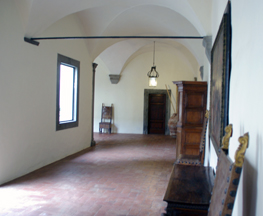
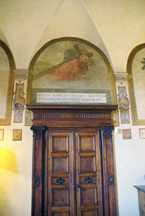 The hallway has old one-of-a-kind pieces of furniture. The high ceilings are accented with many arches.To the left, one can view the courtyard. In the courtyard is a large fountain, unused at the time of our visit. Upon entering a room that had more modern features, we noticed a bicycle, child’s yellow convertible car and two old sewing machines.
The hallway has old one-of-a-kind pieces of furniture. The high ceilings are accented with many arches.To the left, one can view the courtyard. In the courtyard is a large fountain, unused at the time of our visit. Upon entering a room that had more modern features, we noticed a bicycle, child’s yellow convertible car and two old sewing machines.
As you pass through the corridors, immerse yourself in the history of Badia. View the large frescos that are plentiful throughout the building. Many are of a religious theme.
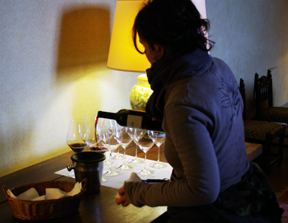 Along the side wall, there was a long table with several wine glasses and two wine bottles. Our guide talked about the wine and distributed Schott wine glasses with a tasting. The wine glasses were large similar to Riedel glassware. At Badia you have time to enjoy a tasting. The Schott glassware were filled about a third full, much more wine than a typical tasting in the U.S. You carry the wine glass with you throughout the tour. Although dump buckets were available, most of the group on the tour enjoyed tasting the wine throughout the tour. Along the way we would stop to taste a different Badia wine. This first tasting was Cancelli IGT, a young wine made from the Sangiovese grape. It had a dark red fruit and black cherries nose with an acid and fruit balance and the hint of soft tannins on the finish.
Along the side wall, there was a long table with several wine glasses and two wine bottles. Our guide talked about the wine and distributed Schott wine glasses with a tasting. The wine glasses were large similar to Riedel glassware. At Badia you have time to enjoy a tasting. The Schott glassware were filled about a third full, much more wine than a typical tasting in the U.S. You carry the wine glass with you throughout the tour. Although dump buckets were available, most of the group on the tour enjoyed tasting the wine throughout the tour. Along the way we would stop to taste a different Badia wine. This first tasting was Cancelli IGT, a young wine made from the Sangiovese grape. It had a dark red fruit and black cherries nose with an acid and fruit balance and the hint of soft tannins on the finish.
Next we went to another hallway and a short distance from the cellar door we enjoyed our second tasting. This wine was Cetamura Chianti DOCG produced with 90% Sangiovese and 10% Canaiolo. It had a fruit flavor, was dry and the acid and tannins were balanced. The group of twelve enjoyed tasting the wine and conversing about it and other topics of interest. Our guide took plenty of time during the tastings to answer questions about the history and the wine at Badia.
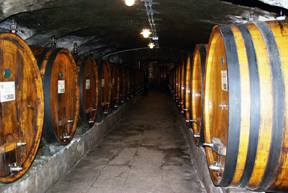
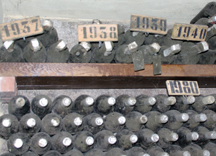 Now it was time to enter the ancient wine cellar. The cellar was originally the crypt and burial chamber but eventually the burial chamber was moved. Here we saw very large oak barrels aging many liters of wine. The barrels are French oak filled with Chianti Classico. Leonardo de Vinci designed the top of the barrel. The cellar similar to a large cave had lichen growing on the walls and the air was damp. Reaching the end of one tunnel, we arrived in a small room where wines were aging. Many years had past since these bottles had been touched. A thick layer of dust covered the bottles. The earliest bottles being stored were from 1937. Only about five bottles of the 1937 wine were on the shelf.
Now it was time to enter the ancient wine cellar. The cellar was originally the crypt and burial chamber but eventually the burial chamber was moved. Here we saw very large oak barrels aging many liters of wine. The barrels are French oak filled with Chianti Classico. Leonardo de Vinci designed the top of the barrel. The cellar similar to a large cave had lichen growing on the walls and the air was damp. Reaching the end of one tunnel, we arrived in a small room where wines were aging. Many years had past since these bottles had been touched. A thick layer of dust covered the bottles. The earliest bottles being stored were from 1937. Only about five bottles of the 1937 wine were on the shelf.
After we left the cellar behind, we entered a separate room where we enjoyed our third tasting. The Sangioveto di Toscana IGT was produced from 100% Sangiovese grapes, aged in oak for one year then aged another year in bottles. We tasted a 2001 vintage. It had a dark ruby red color with hints of raisins and a black cherries bouquet. It had a fruit taste and balanced acids and tannins. This wine will improve with aging.
Medici is the second surname of the family-run winery and vineyards. Today four brothers own Badia a Coltibuono, each in charge of a different aspect. The four areas are vineyard & winery, restaurant, bed and breakfast and the cooking school. Badia a Coltibuono produces about 125,000 cases of wine. The wines are distributed throughout the world. The family produced wine in the 1800’s but has only produced wine commercially for the past 25 years. Presently they have 77 hectares (190 acres) of vineyards.
Beyond the large stone church is the restaurant located in a renovated building. If you decide to eat here, you may want to try the boar stew, or perhaps the baked potato sliced with butter and bay leaves between.
GPS N 43° 29.683’ E 011° 27.066’
Visit these tour operators that partner with Wine Trail Traveler.
 |
||||
|
Spain and Portugal |
SmoothRed London, England, United Kingdom |
